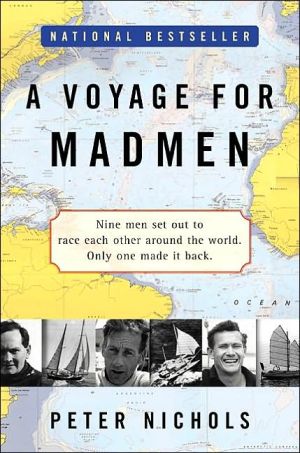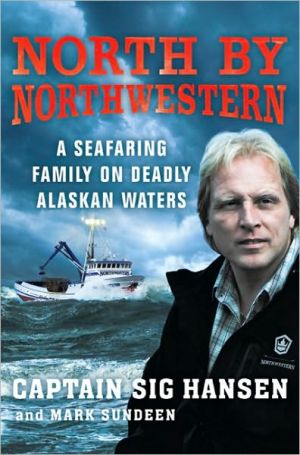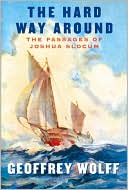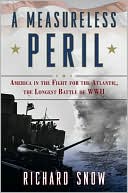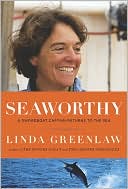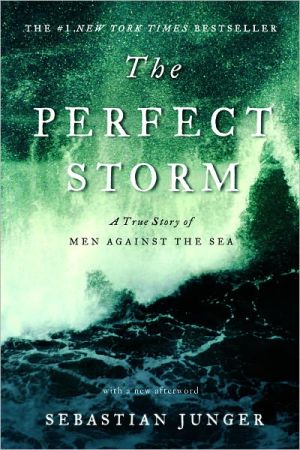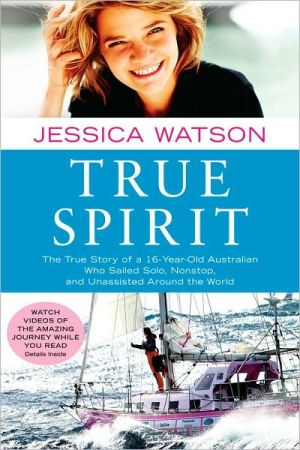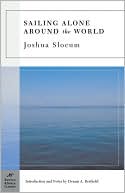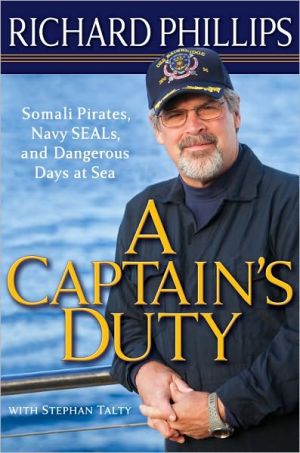Voyage for Madmen
In 1968, nine sailors set off on the most daring race ever held: to single-handedly circumnavigate the globe nonstop. It was a feat that had never been accomplished and one that would forever change the face of sailing. Ten months later, only one of the nine men would cross the finish line and earn fame, wealth, and glory. For the others, the reward was madness, failure, and death.\ In this extraordinary book, Peter Nichols chronicles a contest of the individual against the sea, waged at a...
Search in google:
In 1968 nine sailors set off on the most daring race ever held: to single-handedly circumnavigate the globe nonstop. It was a feat that had never been accomplished—and one that would forever change the face of sailing. Ten months later, only one of the nine men would cross the finish line and earn fame, wealth, and glory. For the others, the reward was madness, failure, and death.In this extraordinary book, Peter Nichols chronicles a contest of the individual against the sea, waged at a time before cell phones, satellite dishes, and electronic positioning systems. A Voyage for Madmen is a tale of sailors driven by their own dreams and demons, of horrific storms in the southern ocean, and of those riveting moments when a decision means the difference between life and death. A classic tale of endurance and adventure, A Voyage for Madmen is also a marvelously told story of obsession and the unpredictable winds of fate itself. Bookseller (London) [Peter Nichols'] account of the gripping round the world yacht race of 1968 ... could be another Perfect Storm. ... [It] tells of another age of human endeavor and lonely struggle against the sea.
In 1966-1967, A 65-year-old Englishman, Francis Chichester, sailed alone around the world. He stopped only once, in Australia. \ A tall, thin, balding man with thick-lensed glasses, Chichester looked more like a prep school headmaster than an adventurer. He owned a small book and map store in London. He was a vegetarian. But the urge to subject himself to extreme tests characterized his life. In his youth he made a pioneering flight in a small aircraft from England to Australia. In 1960, at the age of 59, he and four friends made a wager to race each other single-handedly in their four very different boats across the Atlantic. The course began at Plymouth's Eddystone Lighthouse and finished at the Ambrose light vessel off New York Harbor; the route between these two points was up to the racers. There were no other rules. The winner would receive half a crown.\ Francis Chichester won the bet and the race. Sailing his 39-foot sloop Gypsy Moth III, the largest boat of the five, he made Ambrose in 40 days. But winning was not enough; he thought he could do it faster. Two years later, racing nobody but himself, he crossed the Atlantic again, cutting more than 6 days off his earlier voyage. Still he was not happy with his time; he believed a crossing of less than 30 days was possible.\ The London Observer had covered the 1960 race and found that it owned a story with major and growing public interest. Four years later, in 1964, the Observer sponsored a second single-handed transatlantic race (now famously known by its acronym, OSTAR). Ten additional competitors joined the original group. One of the newcomers, the Frenchman Eric Tabarly, trounced the fleet and took the honors in 27 days, 3 hours, 56 minutes. Chichester came second, 20 hours and 1 minute later. He beat his personal target time handily, but second was a new place for him, an ignominious position for a lone adventurer.\ Tabarly was awarded the Legion of Honor and became a national hero in France: "Thanks to him it is the French flag that triumphs in the longest and most spectacular race on that ocean which the Anglo-Saxons consider as their special domain," proclaimed the Paris Jour.\ Single-handed racing hit the big time. National pride on both sides of the English Channel, from two nations famous for their sense of superiority, xenophobia, and rivalry, now focused on the third OSTAR, due to be held in 1968. At least forty sailors announced plans to compete. Many had new, experimental craft designed and built solely for the purpose of winning that one race. Eric Tabarly was building a new 67-foot trimaran, capable of tremendous speeds; at the time this was a radical reappraisal of the size of boat one person could handle. These boats, with their size and gear and engineering, became so expensive that they were beyond the reach of ordinary sailors. Yacht racing began to resemble motor racing, and the long, increasingly ugly hulls were plastered with commercial logos.\ A few sailors felt this was veering too far from the notion of "sport." They wrote disapproving letters to yachting magazines, dropped away, and left the field to younger sailors who were learning to navigate the tide rips and currents of commercial sponsorship.\ Chichester decided not to compete with the pack in 1968. He would be up against younger men sailing larger boats, and the outcome must have been clear to him: he would be the game old campaigner who would manage a respectable placing halfway through the fleet. He quietly set off to do something else.\ Sailing alone around the world was nothing new. The Nova Scotian-born American Joshua Slocum, a sailing ship master beached in his middle years by the steam age, was the first to do it, in 1895-1898. He sailed from Gloucester, Massachusetts, west-about around the globe, against ferocious prevailing winds through the Strait of Magellan, north of Cape Horn, in a seemingly unhandy, fat-hulled, engineless old oystering sloop that he had rebuilt himself and christened Spray. The Spray's seagoing abilities, and what Slocum managed to do with her, have been wondered at and argued over by sailors ever since. Slocum (who couldn't swim and nearly drowned trying to set an anchor off the Uruguayan coast) stopped in many places and wrote a drily humorous yet thrilling book of his adventure, Sailing Alone Around the World. One hundred years later it is still the standard by which all other sailing narratives are gauged.\ Eighteen other men had circumnavigated alone by the time Chichester set out in 1967, but his voyage caught the public imagination as perhaps none other since Slocum's. It was no pleasure cruise. His route was down the Atlantic, east-about around the bottom of the world, back up the Atlantic. Virtually all the east-to-west part of his circumnavigation took place in a sea not found on most atlases but infamously known to all sailors as the Southern Ocean: the windswept southerly wastes of the Atlantic, Pacific, and Indian Oceans between latitudes 40 and 60 degrees south, between the habitable world and the Antarctic, where storm-force westerly winds develop and drive huge seas around the globe, unimpeded by land except at one fearsome place, Cape Horn, the southernmost rock of the Andes, the scorpion-tail tip of South America.\ Sailors have respectfully and fearfully labeled the latitudes of this global band of turbulent water the Roaring Forties, the Furious Fifties, the Screaming Sixties. The tea clippers from India and China and the square-rigged grain ships from Australia took this route back to Europe because, blown by the westerlies through the desolate seas of the Forties and Fifties, circling the planet at a short, high latitude, it was the fastest way around the world.\ But it took sailors through the most isolated area of the globe, the emptiest expanse of ocean, the remotest place from land.
\ From Barnes & NobleThis thrilling adventure tale chronicles the experiences of nine sailors locked in a treacherous race around the world. In 1968, when no sailor had circumnavigated the globe without stopping, these nine men -- one of whom had no previous sailing experience -- set out from various departure points in the British Isles, each of them alone. Dubbed the Golden Globe race by its sponsor, The London Sunday Times, the race attracted a vast amount of attention from all over the world. After ten months at sea, battling harsh weather conditions and surviving without any advanced equipment, only one of the nine sailors crossed the finish line. One of the finest aspects of A Voyage for Madmen is the author's ability to convey the intensity of the race in spare, candid prose, without trivializing the events or lapsing into melodrama. Nichols's narrative encompasses the characters and histories of the sailors, the disasters and storms, and the other important details that make the story viscerally real.\ \ \ \ \ Sebastian Junger"Extraordinary ...One of the most gripping sea stories I have ever read."\ \ \ Booklist"Reads like a suspense novel."\ \ \ \ \ San Diego Union Tribune“Fascinating...A great story...an excellent examination of the world’s first nonstop, solo race around the world.”\ \ \ \ \ Wall Street Journal"Spellbinding."\ \ \ \ \ The Oregonian"A haunting story...[that] succeeds on the grandest scale."\ \ \ \ \ San Diego Union-Tribune"Fascinating...A great story...an excellent examination of the world’s first nonstop, solo race around the world."\ \ \ \ \ Derek LundyPeter Nichols has written a compulsively readable book that has everything a sea story should have. A Voyage For Madmen evokes the uniquely terrifying hazards and demands of the sea and, with a novelist's skill for character and detail, shows how nine single-handed sailors in their puny and inadequate boats undertook the last great maritime feat—the longest, loneliest sea voyage in history—and how, one by one, the sea cut them down. A marvelous book.\ \ \ \ \ Daniel HaysA great book that combines the amazing stories of nine lone adventurers into a narrative so seamless that it made me want to drop everything to do what these men did: sail around the world alone. A Voyage For Madmen is a thoroughly exciting account of a historical event that changed how we perceive our world.\ \ \ \ \ Richard RaynerA wonderful, terrifying book about aspiration and fallibility, and how success and doom and madness are kept apart from each other by the slenderest of threads.\ \ \ \ \ Bookseller[Peter Nichols'] account of the gripping round the world yacht race of 1968 ... could be another Perfect Storm. ... [It] tells of another age of human endeavor and lonely struggle against the sea.\ \ \ \ \ Publishing NewsA Voyage for Madmen is like a whodunit thriller ... A superb book.\ \ \ \ \ Bookseller (London)[Peter Nichols'] account of the gripping round the world yacht race of 1968 ... could be another Perfect Storm. ... [It] tells of another age of human endeavor and lonely struggle against the sea.\ \ \ \ \ Publishing News (London)A Voyage for Madmen is like a whodunit thriller ... A superb book.\ \ \ \ \ Wall Street JournalSpellbinding.\ \ \ \ \ OregonianA haunting story...[that] succeeds on the grandest scale.\ \ \ \ \ San Diego Union TribuneFascinating...A great story...an excellent examination of the world's first nonstop, solo race around the world.\ \ \ \ \ Sebastian JungerExtraordinary ...One of the most gripping sea stories I have ever read.\ \
